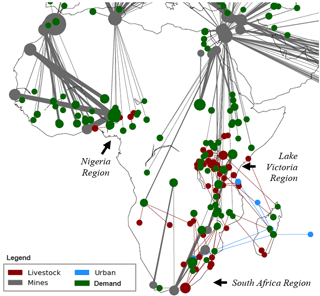Barker, J. C., Hodges, S. C., and Walls, F. R.: Livestock Manure
Production Rates and Nutrient Content, 1–4, 2001.
CBS (Centraal Bureau voor de Statistiek): Dierlijke mest en
mineralen 2013, The Hague: Centraal Bureau voor de Statistiek, available at:
https://www.cbs.nl/-/media/imported/documents/2014/49/2014-dierlijke-mest-en-mineralen-2013-pub.pdf (last access: 11 October 2016),
2014.
CIESIN (Center for International Earth Science Information Network):
Columbia University, Gridded Population of the World, Version 4
(GPWv4): Population Density, https://doi.org/10.7927/H4NP22DQ, 2016.
Cordell, D., Drangert, J.-O., and White, S.: The story of
phosphorus: Global food security and food for thought, Glob. Environ.
Change, 19, 292–305, https://doi.org/10.1016/j.gloenvcha.2008.10.009,
2009.
Gilmour, D., Blackwood, D., Comber, S., and Thornell, A.:
Identifying human waste contribution of phosphorus loads to domestic
wastewater, Proceedings at the 11th International Conference on Urban
Drainage, Held in Edinburgh, Scoltand, UK, 1–10,
https://web.sbe.hw.ac.uk/staffprofiles/bdgsa/11th_International_Conference_on_Urban_Drainage_CD/ICUD08/pdfs/740.pdf
(last access: 27 November 2017), 2008.
Heffer, P. and Prud'homme, M.: Medium-Term Outlook for Global
Fertilizer Demand, Supply and Trade 2008–2012, 76th IFA Annual Conference
Vienna (Austria), 19–21 May 2008.
IFDC (International Center for Soil Fertility and Agricultural Development):
gricultural Production and Soil Nutrient Mining in Africa: Implications for
Resource Conservation and Policy Development, IFDC: Muscle Shoals, Alabama
35662, USA, 2006.
Index Mundi Commodity Price Indices: DAP Fertilizer, available at:
http://www.indexmundi.com/commodities/, last access: 15 July 2017.
Robinson, T. P., William Wint, G. R., Conchedda, G., van Boeckel, T. P.,
Ercoli, V., Palamara, E., and Gilbert, M.: Mapping the
global distribution of livestock, PLoS ONE, 9, e96084,
https://doi.org/10.1371/journal.pone.0096084, 2014.
Schoumans, O. F., Bouraoui, F., Kabbe, C., Oenema, O., and van Dijk, K. C.: Phosphorus management in Europe in a changing world, Ambio, 44,
180–192, https://doi.org/10.1007/s13280-014-0613-9, 2015.
Shu, L., Schneider, P., Jegatheesan, V., and Johnson, J.: An
economic evaluation of phosphorus recovery as struvite from digester
supernatant, Bioresource Technol., 97, 2211–2216.
https://doi.org/10.1016/j.biortech.2005.11.005, 2006.
Smil, V.: Phosphorus in the environment: Natural flows and human
interferences, Annu. Rev. Energ. Env., 25, 53–88,
https://doi.org/10.1146/annurev.energy.25.1.53, 2000.
Steen, I.: Management of a non-renewable resource, Phosphorus and
Potassium, 217, 25–31,
1998.
Steduto, P., Hsiao C., T., Fereres, E., and Raes, D. FAO Irrigation
and Drainage Paper: Crop Yield Response to Water, Rome: Food and Agriculture
Organization of the United Nations (FAO), 2012.
USGS (United States Geological Survey): Mineral Commodity Summary
Phosphate Rock, 2007.
Van Vuuren, D. P., Bouwman, A. F., and Beusen, A. H. W.: Phosphorus
demand for the 1970–2100 period: A scenario analysis of resource depletion,
Glob. Environ. Change, 20, 428–439.
https://doi.org/10.1016/j.gloenvcha.2010.04.004, 2010.






